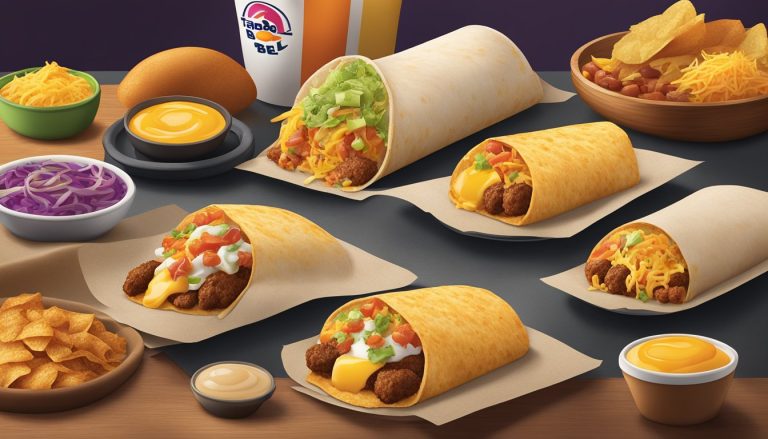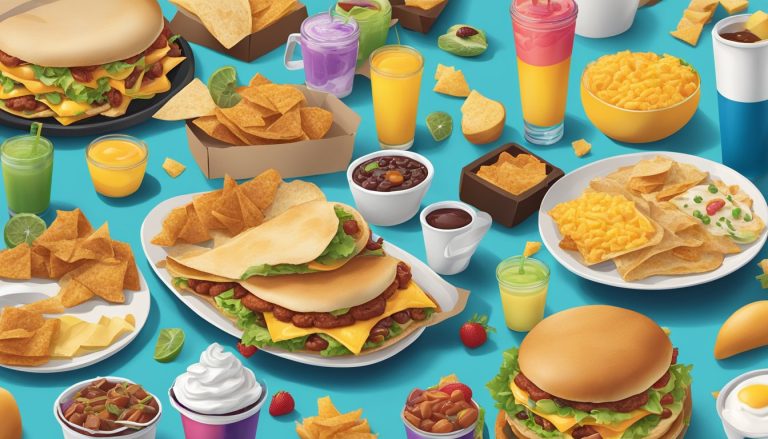Taco Bell’s entry into the breakfast market has reshaped morning routines for many families across the United States. The fast-food chain’s innovative approach to breakfast offerings provides a fresh alternative to traditional morning meals. By introducing a diverse menu of breakfast items, Taco Bell has tapped into the evolving needs of busy families seeking convenient and tasty options to start their day.
The introduction of Taco Bell’s breakfast menu in 2014 marked a significant shift in the fast-food landscape. With items like breakfast burritos and AM Crunchwraps, the chain blended familiar breakfast ingredients with its signature Tex-Mex flavors. This unique fusion appealed to consumers looking for something different from the standard breakfast fare.
Taco Bell’s breakfast innovation extends beyond just the food. The chain’s extended breakfast hours and drive-thru services cater to the changing dynamics of family morning routines. As more families juggle busy schedules, the flexibility and convenience offered by Taco Bell’s breakfast options have become increasingly attractive, altering how many households approach their morning meals.
Rise of Taco Bell in the Breakfast Market

Taco Bell’s entry into the breakfast market marked a significant shift in the fast-food industry. The company’s innovative approach and unique menu items quickly captured consumer attention and market share.
History and Evolution of Breakfast Offerings
Taco Bell introduced its breakfast menu nationwide on March 27, 2014. This launch was supported by the brand’s largest marketing campaign to date. The menu featured distinctive items like the Waffle Taco and Crunchwrap, combining familiar breakfast ingredients in novel ways.
These offerings focused on portability and customization, appealing to on-the-go consumers. The 1980s and 1990s saw Taco Bell experimenting with breakfast options, but it wasn’t until 2014 that a full-scale breakfast menu was implemented.
The company’s breakfast initiative represented a bold move to compete with established players in the morning fast-food market.
Analyzing Market Share and Breakfast Market Dynamics
Taco Bell’s breakfast menu quickly gained popularity among consumers. Market research indicated a positive reception from both critics and customers. The brand’s unique take on breakfast foods helped carve out a niche in a highly competitive market.
Taco Bell’s success in the breakfast segment prompted responses from competitors, leading to increased innovation across the industry. The company’s market share in the breakfast category grew steadily, challenging traditional breakfast leaders.
Factors contributing to Taco Bell’s breakfast success include:
- Unique menu items
- Competitive pricing
- Strong marketing campaigns
- Appeal to younger demographics
These elements helped Taco Bell establish a strong presence in the breakfast market, altering the dynamics of morning fast-food consumption.
Analyzing Family Morning Routines

Family morning routines have evolved significantly with the introduction of fast-food breakfast options. Consumer preferences are shifting as families adapt to busier lifestyles and seek convenient alternatives to traditional home-cooked meals.
Impact of Fast-Food Breakfast on Mornings
Fast-food breakfast options have reshaped family morning routines. Taco Bell’s entry into the breakfast market provides a quick and diverse menu for families on the go. This shift has reduced time spent on meal preparation at home.
Drive-thru services and extended breakfast hours cater to families with varying schedules. Parents can now grab breakfast for themselves and their children without the stress of cooking.
Fast-food breakfasts often offer a mix of sweet and savory choices. This variety appeals to different family members’ tastes, potentially reducing morning conflicts over meal options.
Shifts in Consumer Breakfast Behavior
Consumer breakfast habits have changed dramatically in recent years. More families are opting for convenient, portable meals to accommodate busy mornings.
Key changes in breakfast behavior:
- Increased preference for on-the-go options
- Greater demand for diverse menu choices
- Shift from traditional sit-down breakfasts to quick meals
Families now prioritize speed and convenience over elaborate home-cooked breakfasts. This trend has led to a rise in fast-food breakfast consumption.
Some families view breakfast outings as a treat or bonding opportunity. Fast-food restaurants capitalize on this by creating inviting morning environments.
Taco Bell’s Breakfast Menu
Taco Bell’s breakfast menu offers a unique twist on morning fare, combining Mexican-inspired flavors with classic breakfast ingredients. The menu features signature items, provides nutritional information, and includes options for various dietary preferences.
Signature Breakfast Items
The Breakfast Crunchwrap stands out as a popular choice, combining scrambled eggs, bacon or sausage, cheese, and hash browns in a grilled tortilla. The Breakfast Burrito offers a more traditional take, filled with eggs, cheese, and meat.
The Waffle Taco, while no longer available, was a notable innovation that helped launch Taco Bell’s breakfast menu in 2014. It featured a waffle folded into a taco shape, filled with eggs, cheese, and meat.
Cinnabon Delights provide a sweet option, consisting of warm, bite-sized pastries filled with Cinnabon frosting.
Nutritional Information: Calories and Fat Content
Taco Bell provides nutritional information for its breakfast items:
- Breakfast Crunchwrap (Bacon): 670 calories, 42g fat
- Grande Toasted Breakfast Burrito (Steak): 560 calories, 29g fat
- Hash Brown: 160 calories, 11g fat
- Cinnabon Delights (2 pack): 160 calories, 9g fat
These items tend to be high in calories and fat, reflecting their status as indulgent breakfast options.
Vegetarian and Protein Rich Options
Taco Bell offers vegetarian-friendly breakfast choices:
- Cheesy Toasted Breakfast Burrito: 350 calories, 16g protein
- Hash Brown Toasted Breakfast Burrito: 570 calories, 13g protein
For those seeking high-protein options:
- Grande Toasted Breakfast Burrito (Steak): 560 calories, 26g protein
- Breakfast Crunchwrap (Bacon): 670 calories, 21g protein
These items provide alternatives for customers with specific dietary needs or preferences.
Innovations and Unique Offerings
Taco Bell revolutionized fast-food breakfast with creative menu items and Mexican-inspired flavors. The chain’s innovative approach set it apart from competitors and attracted customers seeking new morning meal options.
Product Development and Mexican-Inspired Flavors
Taco Bell’s breakfast menu incorporated signature Mexican flavors into traditional morning fare. The chain introduced items like the Breakfast Burrito, featuring scrambled eggs, cheese, and choice of bacon or sausage wrapped in a warm tortilla.
Another popular offering was the A.M. Crunchwrap, a twist on Taco Bell’s classic Crunchwrap Supreme. This breakfast version contained scrambled eggs, hash browns, cheese, and bacon or sausage in a grilled tortilla.
The Breakfast Quesadilla combined eggs, cheese, and meat in a folded and grilled tortilla. Taco Bell also created sweet options like Cinnabon Delights – warm donut holes filled with icing.
The Role of Taco Bell’s Unique Menu Items
The Breakfast Crunchwrap became a standout item on Taco Bell’s morning menu. Its portable format and satisfying combination of textures appealed to on-the-go customers.
Taco Bell introduced the Biscuit Taco, a taco-shaped biscuit filled with eggs, cheese, and meat. This innovative item showcased the chain’s ability to merge familiar breakfast elements with its signature taco concept.
The Waffle Taco, featuring a folded waffle filled with eggs, cheese, and meat, garnered significant media attention. While short-lived, it demonstrated Taco Bell’s willingness to experiment with unconventional breakfast ideas.
Taco Bell’s unique offerings helped differentiate its breakfast menu from competitors. These items attracted curious customers and fostered brand loyalty among those seeking alternatives to traditional fast-food breakfast options.
Branding and Marketing Strategies
Taco Bell’s breakfast initiative relies on innovative branding and targeted marketing campaigns. These strategies aim to establish a unique identity and reach consumers through digital channels and influencer partnerships.
Establishing A Strong Brand Identity
Taco Bell’s breakfast brand identity centers on bold flavors and unconventional menu items. The company leverages its reputation for Mexican-inspired cuisine to differentiate its morning offerings from traditional breakfast fare.
Bright, eye-catching packaging and playful product names reinforce the brand’s fun, youthful image. Menu items like the Breakfast Crunchwrap and Cinnabon Delights set Taco Bell apart from competitors’ more conventional options.
The brand emphasizes value and convenience, targeting busy millennials and Gen Z consumers. Taco Bell positions its breakfast as a quick, affordable alternative to sit-down restaurants or time-consuming home-cooked meals.
Digital and Influencer Marketing Campaigns
Taco Bell heavily utilizes social media platforms to promote its breakfast menu. The company creates engaging content across Instagram, TikTok, and Twitter to showcase new items and limited-time offers.
Influencer partnerships play a key role in Taco Bell’s breakfast marketing strategy. The brand collaborates with popular content creators to reach younger audiences and generate buzz around menu launches.
Digital ads target consumers during key morning hours, reminding them of Taco Bell as a breakfast option. Mobile app promotions and loyalty program rewards incentivize repeat visits and help build a regular breakfast customer base.
Operational Details

Taco Bell’s breakfast venture required significant operational adjustments. The company implemented new hours and developed a specialized morning menu to appeal to early risers.
Breakfast Hours and Accessibility
Taco Bell introduced breakfast service from 6 AM to 11 AM daily. This early start time aimed to capture commuters and those seeking a quick morning meal. The extended hours allowed flexibility for customers with varying schedules.
To ensure smooth operations, Taco Bell trained staff specifically for breakfast shifts. This included familiarizing employees with new equipment and food preparation techniques unique to morning offerings.
Drive-thru service played a crucial role in breakfast accessibility. Taco Bell optimized drive-thru lanes to handle increased morning traffic, recognizing the importance of speed for time-pressed customers.
Exploring the Morning Menu
Taco Bell’s breakfast menu featured a mix of traditional items with a Mexican-inspired twist. Key offerings included:
- Breakfast Crunchwraps
- Breakfast Burritos
- Cinnabon Delights
- Coffee and orange juice
The menu balanced familiar breakfast staples with innovative creations. Egg-based dishes formed the core of the offerings, complemented by hash browns and various meat options.
Taco Bell emphasized customization, allowing customers to modify ingredients according to their preferences. This approach catered to diverse dietary needs and taste preferences.
Pricing remained competitive, with many items available for under $5. This strategy aimed to attract budget-conscious consumers and compete with established breakfast players.
Competitive Landscape
Taco Bell’s entry into the breakfast market sparked intense competition among quick-service restaurants. The move reshaped morning dining options and challenged established players in the industry.
Comparison with McDonald’s and Other QSRs
McDonald’s, the long-standing breakfast leader, faced direct competition from Taco Bell’s innovative menu items. Taco Bell introduced unique offerings like the Waffle Taco and Breakfast Crunchwrap, distinguishing itself from traditional breakfast fare.
Other QSRs like Burger King and Wendy’s also revamped their breakfast menus in response. This led to increased variety and value for consumers. Taco Bell’s late entry allowed it to learn from competitors’ successes and failures.
The company capitalized on its Mexican-inspired cuisine to create a distinct breakfast identity. This strategy helped Taco Bell carve out a niche in the crowded breakfast market.
Navigating the QSR Industry
Taco Bell’s breakfast launch required careful navigation of the QSR industry’s complexities. The company faced challenges in changing consumer habits and convincing franchisees to extend operating hours.
To succeed, Taco Bell invested heavily in marketing and promotions. They targeted younger demographics with bold flavors and unconventional menu items. The company also focused on drive-thru efficiency to cater to time-pressed morning customers.
Taco Bell’s breakfast initiative influenced industry-wide trends. It prompted other chains to innovate and diversify their morning offerings. This shift led to increased competition and raised the bar for breakfast quality across the QSR sector.
Consumer Engagement
Taco Bell’s breakfast strategy hinged on understanding and responding to consumer needs. The company focused on gathering customer insights and tailoring offerings to match morning cravings.
Leveraging Customer Feedback
Taco Bell actively sought consumer input to refine its breakfast menu. The company conducted surveys and focus groups to identify preferences and pain points. This data-driven approach led to menu adjustments and new product development.
Social media played a crucial role in gathering real-time feedback. Taco Bell monitored online conversations and trends to stay attuned to changing tastes. The brand also encouraged customers to share their breakfast experiences, creating a sense of community and brand loyalty.
Meeting Morning Cravings and Needs
Taco Bell recognized the importance of catering to diverse morning appetites. The menu featured a mix of traditional breakfast items with a Mexican-inspired twist. This included breakfast burritos, quesadillas, and the popular Breakfast Crunchwrap.
To address the need for convenience, Taco Bell optimized its drive-thru service for quick morning pickups. The brand also introduced portable breakfast items for on-the-go consumption.
Coffee became a key focus, with Taco Bell partnering with a specialty roaster to develop a unique blend. The addition of breakfast salsa provided a spicy option for those seeking bolder flavors in the morning.




